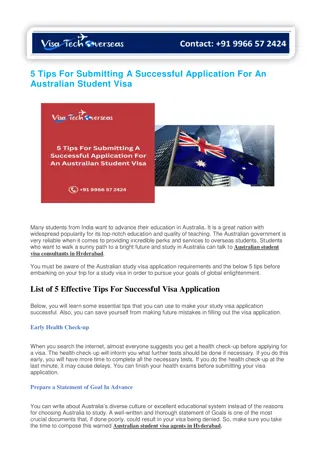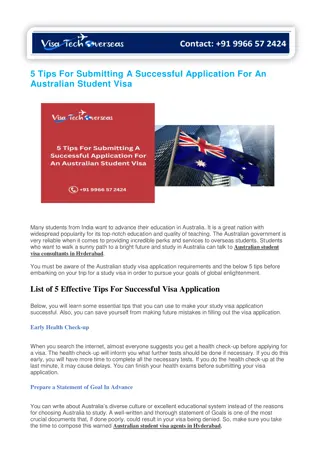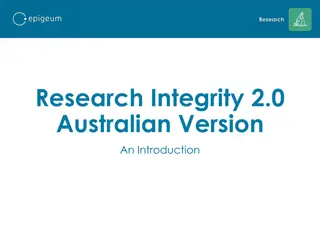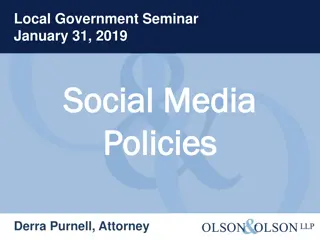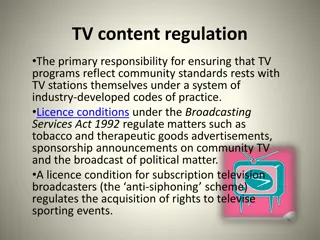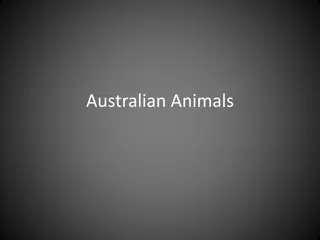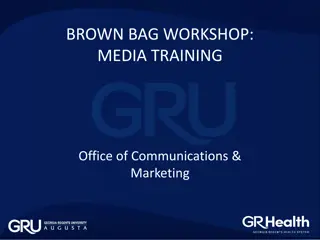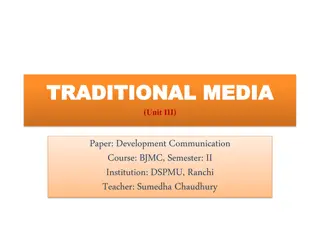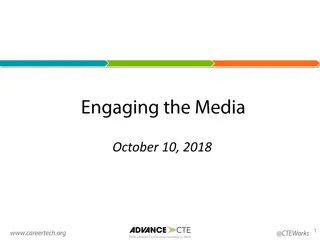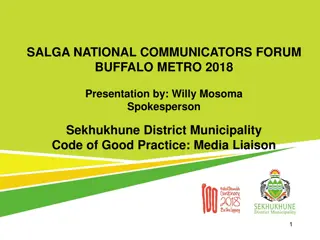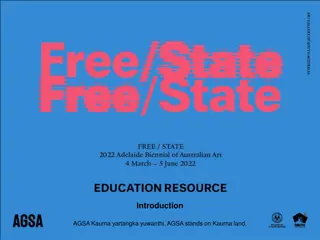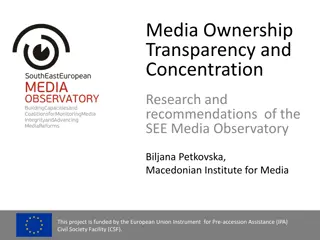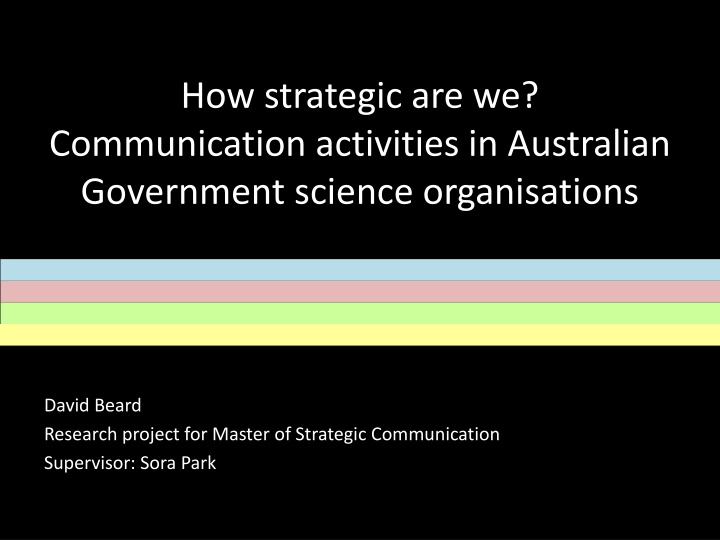
Communication Activities in Australian Government Science Organizations - Research Project by David Beard
Explore the strategic communication practices within Australian Government science organizations through David Beard's research project. The study delves into the use of communication to fulfill organizational missions, focusing on the role of strategic communication as an organizational management function. Discover insights on improving communication strategies in Government science entities.
Download Presentation

Please find below an Image/Link to download the presentation.
The content on the website is provided AS IS for your information and personal use only. It may not be sold, licensed, or shared on other websites without obtaining consent from the author. If you encounter any issues during the download, it is possible that the publisher has removed the file from their server.
You are allowed to download the files provided on this website for personal or commercial use, subject to the condition that they are used lawfully. All files are the property of their respective owners.
The content on the website is provided AS IS for your information and personal use only. It may not be sold, licensed, or shared on other websites without obtaining consent from the author.
E N D
Presentation Transcript
How strategic are we? Communication activities in Australian Government science organisations David Beard Research project for Master of Strategic Communication Supervisor: Sora Park
Definitions Strategic communication The purposeful use of communication by an organization to fulfill its mission Hallahan et al. 2007, p. 3 Institutions Commonly accepted principles, rules, definitions and procedures that shape how people and organisations operate Sandhu 2009
Definitions The research population Australian Government science organisations Australian Federal Government organisations that perform natural science activities including research, funding and regulation. Hallahan et al. 2007, p. 3
Introduction Why Government science organisations? Personal interest - I am a communication manager in a Government science organisation Discrete group Government science organisations can be considered an organisational field Recent public examples of Government science organisations not communicating strategically So, room to improve for these organisations
Literature Review Is strategic communication an organisational function or an individual activity? Some researchers treat strategic communication as an organisational management function Others treat it as an individual activity Strategic communication is done by an individual Particularly done by senior managers
Literature Review This study focuses on strategic communication as an organisational management function SC as an organisational management function is a broader view SC activities flowing from SC as an organisational management function Organisations use individuals as communication agents , but also use other agents publications, websites, social media
Literature Review SC in the private and public sectors SC research has conventionally treated organisations homogenously & focused on private sector organisations (Fredriksson & Pallas 2016a & 2016b) By focusing on Australian Government organisations this study contributes to the understanding of SC practices in the public sector
Literature Review Strategic communication principles Literature review identified 3 SC principles 1. Purposeful alignment of communication strategy to business strategy Evidence-based communication Multidisciplinary approach to communication 2. 3.
Literature Review Purposeful alignment of communication strategy to business strategy Essence of SC is the organization communicating purposefully to advance its mission (Hallahan et al. 2007, p. 4) Requires participation in organisational strategic management (Grunig 2006) Importance of reporting to senior executives, particularly the CEO (Halter 2015; Swerling and Sen 2009; Tindall and Holtzhausen 2011; Zerfass & Sherzada 2015) Long-term focus (Mahoney 2011; Swerling & Sen 2009; Tindall & Holtzhausen 2011)
Literature Review Evidence-based communication Gathering evidence to understand environments Understanding stakeholders & publics Identifying & managing issues (Grunig 2006; Mahoney 2013; Tindall & Holtzhausen 2011; Wakefield, Plowman & Curry 2013; Zerfass & Sherzada 2015) Gathering evidence to evaluate communication efforts Evaluation of organisational benefits, not simply communication benefits (Grunig 2006; Halter 2015; Invernizzi & Romenti 2009; Swerling and Sen 2009)
Literature Review Multidisciplinary approach to communication SC unites traditional communication disciplines (Hallahan et al. 2007 ; Nothhaft 2016; Sandhu 2009; Swerling & Sen 2009; Tindall & Holtzhausen 2011 ; Werder 2015) Multidisciplinarity is a hallmark of strategic communication Werder 2015, p. 79)
Literature Review Other approaches to studying institutionalisation of SC Grunig (2006) identified institutionalisation as an important research challenge for strategic PR SC scholars interest in institutionalisation began in 2009 and has continued to the present Swerling & Sen (2009) identified 4 indicators of institutionalisation common to management functions & relevant to SC: Direct reporting to CEO/senior executives Respect of the function from senior executives Integration with other management functions Measures that demonstrate value These 4 indicators share much in common with my 3 principles But, environmental monitoring is not present Nor is multidisciplinarity Gradien & Johansson (2012) proposed a theoretical framework for the study of institutionalisation of communication management 4 levels of analysis: societal, organisational field, organisational, individual
Literature Review Previous studies of the institutionalisation of SC Most studies have focused on Europe, followed by the United States Assisted by regular surveys of large numbers of communication practitioners European Communication Monitor (ECM) Conducted annually since 2007 2710 respondents from 43 nations in 2016 Generally Accepted Practices (GAP) Annual in the US from 2002-2005, then biennial 347 respondents in 2013 Is strategic communication institutionalised?
Literature Review Partial institutionalisation of SC The European and US studies have demonstrated only partial institutionalisation SC respected by executives & common SC behaviours Comm managers contributed significantly to organisational management & companies measured comm activities Direct access to CEO and respect from executives, but evaluation & integration with other management functions not institutionalised Strategic PR respected by executives in some organisations, but not all Executives understand the value of SC, but see it as something they do as individuals, rather than as a organisational management function Some of these studies argued that SC was institutionalised in Europe However, they did not consider all 3 SC principles identified above, so only demonstrated partial institutionalisation
Literature Review Failed attempts to institutionalise SC A number of European studies have documented failed attempts to institutionalise SC These attempts failed when the senior business and communication staff championing the efforts moved on
Literature Review Australian study Only 1 previous study of institutionalisation of SC in Australian organisations Halter (2005) studied Australian universities Finding partial institutionalisation Respect from executives However, measuring value is an enduring challenge
Literature Review The state of play Zerfass in 2009: Whether strategic communication is deeply rooted in the genes of an organization or only loosely linked to its surface will be realized after the end of the current [economic] downturn. (p. 69) Zerfass & Sherzada in 2015: much remains to be done for strategic communication to become institutionalised
Literature Review Key points from literature review 3 SC principles identified Other research approaches identified: 4 indicators and a framework Previous studies found partial institutionalisation of strategic communication Most studies focus on Europe & the US Only 1 study for Australian organisations Few studies focus on public sector organisations
Research Question and Methods Research question In what ways, and to what extent, is strategic communication institutionalised in Australian Government science organisations?
Research Question and Methods Methods Quantitative online survey Qualitative semi-structured Interviews 24 organisations invited to participate 6 organisations participated 20 completed the survey (2 partial) Focused on alignment between communication strategy and business strategy. Focused on the 3 strategic communication principles Participants The most senior communication manager Institutionalisation 3 principles deemed to be institutionalised in the organisational field if they are accepted and practised in most of the organisations
Research Question and Methods Research framework Concepts: Strategic communication Institutionalisation The 3 SC principles are dimensions of SC The survey and interviews gathered data for multiple indicators for the institutionalisation of the 3 principles
Research Question and Methods Online self-completion survey 135 questions 127 closed questions 8 open questions but this data did not help to address the research question, so not included Logic paths meant no participant needed to answer all 135 questions Questions catered for the reality that SC may be applied at the whole of organisation level or for individual significant projects Validity of the indicators for the 3 principles Determined using face validity the indicators appear to represent the concepts The researcher s 4 years of experience as the most senior communication manager in a Government science organisation was relied upon for this face validity Reliability of the indicators not assessed, but validity assumes reliability Survey completed during Sep and Oct 2016 18 participants completed the survey in full Another 2 participants completed the survey in part
Research Question and Methods Interviews Validity of the indicators determined using face validity again Convenience sampling But, interviewees came from larger, medium & smaller organisations From organisations that work in different scientific fields 1 interviewee was an EB member, the other 5 report to EB members
Research Question and Methods High participation rate 80% of the study population participated via the survey Why so high? The researcher was the most senior communication manager in an Australian Government science organisation an insider Research integrity Participant for the researcher s own organisation was another communication manager
Findings - Purposeful alignment of communication strategy to business strategy Executive Board engagement Comms Manager EB reporting Regularity of EB engagement 15% Multiple times a day 20% 5% Once a day 10% Multiple times a week 30% 50% 65% Multiple times a month Once a month Report to the CEO 5% Report to another EB member Report to no one on the EB
Findings - Purposeful alignment of communication strategy to business strategy Documented strategies Organisations with comms strategies Organisations with current organisational comms strategies 25% 25% 10% 65% 45% 30% YES - for organisation AND significant projects YES - for organisation ONLY YES - for significant projects ONLY Current NOT current No strategy
Findings - Purposeful alignment of communication strategy to business strategy Strategic content Alignment to business strategies & presence of strategically focussed content (whole of org. comms strategies) 0% 20% 40% 60% 80% 100% Aligned with documented business strategies Informed by input from members of the EB Informed by communication environment info Contains goals and/or objectives Identifies audiences? Contains success measures Yes No No whole of org. comm. strategy
Indicator Participant member of EB % 20 Engagement with Executive Board (EB) Participant reports to an EB member 80 Participant engages with EB members at least multiple times per week Other communication practitioners engage regularly with EB members 85 70 Whole organisation Documented communication strategies Exists 75 Is current 45 Updated at least within the past year 55 Updated at least yearly 45 Documented communication strategies alignment and presence of strategically focussed content Aligned with documented business strategy 70 Informed by input from EB members 70 Informed by assessments of the communication environment 70 Contains goals and/or objectives 70 Identifies audiences 75 Contains success measures 60
Findings - Multidisciplinary approach to communication Communication disciplines Overarching disciplines Strategic communication Public relations Marketing Engagement disciplines Media engagement Social media engagement Parliamentary engagement Community engagement Education Internal communication Conferences & events Creative content disciplines Web content management Graphic design Multimedia Writing & editing Cartography
Findings - Multidisciplinary approach to communication Multidisciplinary approach % of organisations that take a multidisciplinary approach to comms planning 11% YES - for organisation & significant projects 11% YES - for organisation ONLY 56% YES - for significant projects ONLY 22% NO - multidisciplinary approach not used
Used by the organisation Overseen by the most senior communication manager Participate in multidisciplinary communication planning For whole organisation For significant projects Overarching disciplines Strategic communication 100 100 78 61 Public relations 83 78 56 50 Marketing 67 56 39 28 Engagement disciplines Media engagement 94 89 72 61 Social media engagement 94 89 67 61 Parliamentary engagement 89 39 39 39 Community engagement 72 44 56 50 Education 67 39 22 11 Internal communication 100 72 67 61 Conferences & events 100 61 33 28 Creative content disciplines Web content management 100 83 56 50 Graphic design 94 83 39 39 Multimedia 78 78 28 28 Writing & editing 100 78 50 39 Cartography 39 11 17 17
Findings - Evidence-based communication Evidence-gathering approaches Understanding environments Market research Stakeholder research Issues reports Media monitoring Media trend reports Web analytics monitoring Web analytics reports Social media analytics monitoring Social media analytics reports Evaluating effectiveness Evaluating communication efforts Evaluation reports
Findings - Evidence-based communication Presence of activities Monitoring, reporting and evaluation activities used, as a % of organisations 0% 20% 40% 60% 80% 100% Market Research Stakeholder Research Yes - for organisation & significant projects Issues Reports Media Monitoring Yes - for the organisation ONLY Media Trend Reports Web Analytics Monitoring Yes - for significant projects ONLY Web Analytics Reports Social Media Analytics Not done Social Media Analytics Reports Communication success criteria Evaluate communication efforts Evaluation Reports
Findings - Evidence-based communication Influence on communication planning Regularity of influence on communication planning - % of organisations 0% 10% 20% 30% 40% 50% 60% 70% 80% 90% 100% Market Research Stakeholder Research Issues Reports Media Monitoring Media Trend Reports Web Analytics Reports Social Media Analytics Reports Evaluation Reports Always Often Occasionally Rarely Never No response Activity not done
Findings - Evidence-based communication Influence on business planning Regularity of influence on business planning - % of organisations 0% 10% 20% 30% 40% 50% 60% 70% 80% 90% 100% Market Research Stakeholder Research Issues Reports Media Monitoring Media Trend Reports Web Analytics Reports Social Media Analytics Reports Evaluation Reports Always Often Occasionally Rarely Never No response Activity not done
Degree of institutionalisation in the organisational field Monitoring, reporting and evaluation activities Distribution to comms managers Influence on comms planning Influence on business planning Presence of activity Regularity of activity Distribution to EB Market research 63 37 53 53 47 32 Stakeholder research 74 32 58 74 42 26 Issues reports 32 32 26 32 21 16 Media monitoring 100 96 89 89 47 26 Media trend reports 32 21 21 21 16 5 Web analytics monitoring 95 N/A N/A N/A N/A N/A Web analytics reports 89 84 79 58 37 5 Social media analytics monitoring Social media analytics reports Evaluating comms efforts 74 N/A N/A N/A N/A N/A 63 63 63 47 26 11 61 N/A N/A N/A N/A N/A Evaluation reports 56 50 50 50 39 22
Findings Key Survey Findings Communication functions have access to EB members Documented communication strategies exist But are not necessarily current Multidisciplinary communication teams exist But some disciplines don t contribute to communication planning Many communication monitoring, reporting & evaluation activities are done But often don t contribute to communication & business planning
Findings The Key Survey Finding The institutionalisation of SC practices does not translate to the institutionalisation of strategic impact from these practices
Interview findings Strategic communication strong in 2 organisations Strategic communication respected by EB and science managers Alignment between communication strategy and business strategy Alignment is excellent and communication planning is interwoven with business planning Why? EB & science managers see business benefits from strategic comms Strategic comms considered early in business planning Long history of public and media interest in the organisation
Interview findings Not so strong in 4 organisations - recognition Recognition of the value of strategic communication patchy Respected by some, but not all EB members Even more patchy for lower level managers In 1 organisation, senior executives use strategic comms well in their individual communication efforts, but do not expect the same from the organisation s efforts Why? Lack of awareness of the business benefits of strategic communication Strong science skills not matched by strong business skills for some EB members and managers
Interview findings Not so strong in 4 organisations - alignment Communication and business strategy done in isolation Communication planning left to the end of projects In the absence of business plans, communication plans become business plans Business and communication plans should work hand-in-hand, but they don t Communication planning often drives business planning, with communication staff standing in the shoes of external stakeholders Communication staff only contribute to business planning when a communication risk or issue is identified by communication staff
Interview findings Not so strong in 4 orgs but improvements underway Communication champions are important CEO recognises the value of SC (3 orgs) A champion on the EB in addition to the CEO (2 orgs) Early adopters amongst science managers (3 orgs) Greater interest in strategic comms due to negative media attention (1 org) Comms managers improving business-comms alignment (4 orgs) Participating in business planning meetings Working with key projects to demonstrate benefits Writing strategies, plans and evaluation reports
Interview findings Interviews - key findings The interview findings support the key survey finding And provide insights into underpinning factors: Awareness of the business benefits of strategic comms is important Strong science skills not matched by strong business skills for some EB members and middle managers Media and public interest in organisations elevates the importance of strategic comms Communication champions are key to driving improvements




